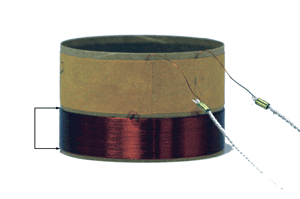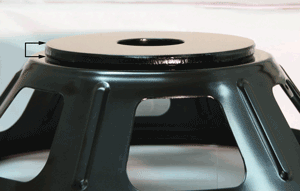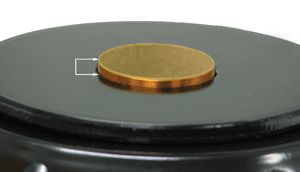 |
| Voice Coil Winding Height |
 |
| Top Plate Thickness |
 |
| Voice Coil Overhang |
Simply stated, the Xmax is the height of the voice coil overhang above and below the top plate and magnetic gap. As the speaker is pushed to a point where less wire is in the magnetic gap, distortion and non-linearities should begin to occur. At an extreme, a mechanical failure would result from playing the voice coil out of the magnetic gap. This extreme would exceed the Xmax and is hopefully beyond the power rating of the speaker.
More Xmax should result in less break-up because more travel is required to push the voice coil wire out of the magnetic gap. However, considering the Xmax figure tends to be relatively low on guitar speakers, this doesn’t lend a lot of insight. You’re essentially comparing speakers that all have lower Xmax. In reality, the real mojo with break-up comes from the cone. For instance, if a guitar speaker with the highest Xmax has a lightweight, thin cone, it’s going to break-up early. So you ask, “How do I know if the cone is lightweight and thin?” Honestly, I’ve never seen raw cone specifications published. Ultimately, we must rely on the speaker manufacturers’ suggestions and expressions regarding break-up modes.
It’s important to consider the rate of speaker breakup. You can look at it as another variable in getting your tone. If your overdriven sounds are a little ratty or harsh, you should try a cleaner speaker. The cleaner speaker will hold together better and should produce a more articulate sound, and you will be relying more on your amp to get your overdrive.
On the other hand, maybe you’re not getting enough dirt at low volumes. A speaker that breaks up earlier may solve the problem. You may even find that you desire a certain speaker’s break-up characteristics. Some of them can be really sweet. I’ve noticed that really good players learn where their speakers break-up and use it to their advantage. They never have to adjust their amp. They use the volume knob on their guitar and vary their pick attack to get exactly the tone they want, when they want it.
Hopefully, this gives you new ideas to improve specific areas of your tone. I encourage you to listen more critically, to find exactly what needs improving and to define your ideal tone
Anthony “Big Tony” Lucas
Big Tony is a guitarist and Senior Lab Technician at Eminence Speaker LLC, where he specializes in guitar-speaker design and customer support. Big Tony has been with Eminence for over 10 years and is responsible for many well-known guitar speaker designs.






![Rig Rundown: Russian Circles’ Mike Sullivan [2025]](https://www.premierguitar.com/media-library/youtube.jpg?id=62303631&width=1245&height=700&quality=70&coordinates=0%2C0%2C0%2C0)

















